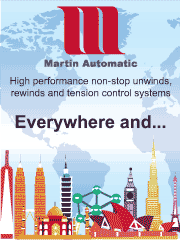The Future of Sustainable Labeling
- Published: June 01, 2025
 Embracing Linerless Technology
Embracing Linerless Technology
By Yara Ghoussoub, Strategic Project Manager, Avery Dennison
Linerless technology is revolutionizing pressure-sensitive adhesive (PSA) labels. Industries such as quick-service restaurants (OSR), grocery, logistics, and warehouse management are leading the charge to adopt the technology, which offers multiple benefits. As the push for sustainability intensifies, linerless technology stands out as a standard-setting solution that combines environmental responsibility with operational excellence.
Today, the market landscape presents an ideal opportunity for converters to expand their capabilities and invest in linerless conversion.
What are Linerless Labels?
In a traditional PSA label construction, the liner facilitates die-cutting, protects the adhesive prior to application, and aids dispensing during application. While that liner plays a crucial role, it often ends up as waste material.
A linerless construction eliminates the liner. Instead, it employs a coating that prevents the adhesive from adhering to the facestock when wound into a roll. This ensures smooth release and clean dispensing from printers and application systems.
Linerless technology is typically used in direct thermal (DT) label applications and has been refined over the years. Today's linerless labels have reached a high level of reliability and ease of use, thereby accelerating their adoption.
Key Advantages of Linerless Labels
Linerless technology offers notable benefits that extend through the label value chain, benefiting manufacturers, converters, and end users.
1. Waste reduction — Liners account for up to 50% of the materials used in traditional constructions, and often become waste. While the industry has worked hard to expand liner recycling efforts, linerless technology takes sustainability a step further by eliminating the need for liners altogether. This not only reduces waste but also eliminates the matrix associated with traditional label materials.
2. Improved end-user efficiency and safety - Linerless labels offer increased end-user efficiency. The siliconized facestock coating allows each adhesive layer to peel easily and cleanly off the underlying layer in a self-wound roll. The user simply prints the label and places it on the intended surface. There's no hassle of removing and discarding a liner.
Linerless technology also allows up to 50% more labels per roll compared to a traditional product, minimizing changeovers. As many DT printers can now print variable lengths, a single label solution can fulfill a wide range of needs.
Linerless technology can also enhance workplace safety. Siliconized liner waste on hard-surface floors can be a significant slip-and-fall risk — especially if a little moisture is added to the mix. With linerless labels, there's no such waste on the floor, helping to mitigate that risk.
3. Improved carbon footprint — Sustainability is one of the major trends revolutionizing not only our industry but many of the industries we serve. By eliminating the liner, linerless labels reduce waste and the need for landfill space. This also translates to fewer raw materials used in production and less energy consumed during manufacturing and transportation. Ultimately, the reduced weight and material usage of linerless labels contribute to a lower carbon footprint, making them a more environmentally friendly choice.
This is likely to become even more significant in the coming years, as new regulations require brands to account for and manage their Scope 3 carbon emissions.1 Using less material and producing less waste, the adoption of linerless labels could emerge as a key tactic in many brands' Scope 3 management strategy.
Where Do We See Linerless Label Adoption?
Versatile linerless technology has countless potential applications. To date, we're seeing a handful of industries spearhead linerless adoption. These include:
Grocery - Linerless labels are being used in applications such as deli, bakery, hot foods, and weigh scale. Virtually any DT application in grocery can benefit from linerless technology.
Quick service restaurants (OSRs) are increasingly turning to linerless labels to enhance order accuracy, increase efficiency and reduce waste.
Shipping and logistics - This competitive industry has expanded dramatically with the growth of e-commerce. Shippers are turning to linerless labels to help their employees gain productivity in applications such as parcel labeling and inventory tracking.
Expanding Into Linerless: Promoting the Technology
Converters looking to expand their operations with linerless capabilities must prioritize promoting the technology and educating customers on its long-term benefits, which can outweigh the upfront investment.
A crucial aspect of this effort is highlighting the increasing availability of direct thermal (DT) printers that are reliable, versatile and fully compatible with linerless materials. As demand for linerless technology grows, more printer OEMs are developing compatible printers and applicators. These manufacturers are enhancing their products with more flexible interfaces and improving material compatibility across various applications.
Material manufacturers who are deeply invested in advancing linerless technology, are collaborating with printer OEMs to ensure a seamless experience for end-users. By providing compatible labels and fostering innovation, these partnerships aim to drive adoption and deliver tangible value to businesses.
A Vision for the Future of Linerless Labeling
As industries focus their efforts on sustainability and productivity, we can expect to see versatile linerless technology used in more applications. Linerless labeling supports sustainable packaging solutions that adhere to regulatory requirements. Linerless constructions with no-phenol-added facestocks that are FSC®-certified align with sustainability and compliance regulations.
Meanwhile, linerless technology offers the potential for more efficient labeling, reducing material consumption while maintaining compliance and brand visibility.
We should also expect additional innovation in adhesive formulations and performance, printing speed and printing equipment. These factors will continue to improve end-user efficiency, enable operational workflows, and enhance the versatility of linerless labels across multiple, diverse market segments such as healthcare, retail and others.
Linerless Poised for Continued growth — is Your Business Ready?
Linerless label technology is gaining traction across a variety of market segments. It's poised for continued growth in coming years, especially as market and regulatory pressures prompt more industries to focus on sustainability and productivity. Converters should prepare themselves now by ensuring their business has the capabilities to serve these industries.
1 https://ghgprotocol.org/corporate-value-chain-scope-3-standard
About the Author
Yara E. Ghoussoub is a Strategic Project Manager at Avery Dennison, where she drives key initiatives at the intersection of innovation and sustainability. Holding a Ph.D. in Materials and Polymer Science from Florida State University, Yara combines deep technical expertise with a passion for translating advanced research into impactful, real-world solutions.
















